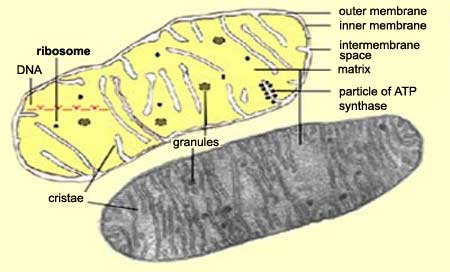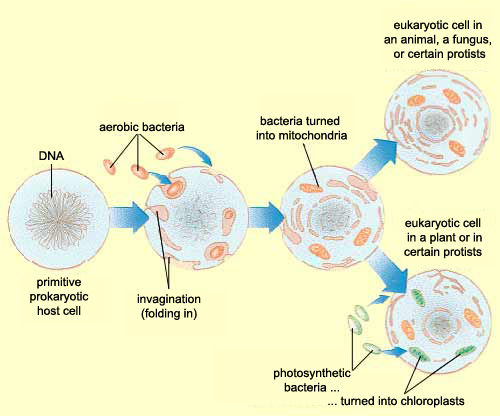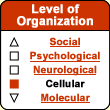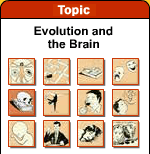|
|
|
|
 |
| Our
Evolutionary Inheritance |
 |
|
|
|

 |
 |
 |

 |
 |
Mitochondria are responsible
for cellular respiration, the process that enabled
eukaryotic cells to break their dependency on the older,
relatively inefficient, anaerobic process of glycolysis.
The fermentation of alcohol is an example of an anaerobic process
involving glycolysis. In fermentation, in the absence of oxygen,
yeast converts the initial substrate, glucose, into ethyl alcohol.
The alcohol thus serves as an internal acceptor for the electrons.
Fermentation is still used for energy production by certain
micro-organisms. It yields a net energy balance of two molecules
of adenosine triphosphate (ATP).
In the cellular respiration that takes place in a mitochondrion,
the oxygen molecule is used as the final electron acceptor.
This molecule offers the advantage of allowing the glucose
molecule to be fully oxidized and completely converted into
water and carbon dioxide. The net energy balance is 38 ATP
molecules: 19 times more than in glycolysis!
The mitochondrion's matrix contains the enzymes needed to break
down the pyruvic acid (obtained from glucose and fatty acids),
while its cristae (folds in its inner membrane) contain the
electron transporters where the ATP is synthesized.
|
|
|
| THE ORIGIN OF MITOCHONDRIA |
|
Eukaryotic cells, with their many intracellular
organelles, were long regarded as descendants of prokaryotes
that grew more complex as the result of genetic mutations. But
in the 1960s, biologist Lynn Margulis proposed an alternative
explanation that initially got a cold reception from the scientific
community. Her endosymbiotic theory, presented more formally
in a book published in 1981, proposes that eukaryotic cells as
we know them today are the result of a series of symbiotic associations
with various prokaryotes.
According to this theory, not only mitochondria, but also chloroplasts
and possibly other organelles, such as lysosomes and flagella,
were originally prokaryotes that took refuge in larger, anaerobic
cells that offered them a rich supply of nutrients. In exchange,
these anaerobic host cells benefitted from the prokaryotes’aerobic
or photosynthetic capabilities. Over time, the aerobic prokaryotes
became mitochondria, while the photosynthetic prokaryotes became
the chloroplasts now found in plant cells. This symbiosis between
aerobic prokaryotes and the anaerobic ancestors of eukaryotic cells
would have
given both of them advantages for surviving in an environment where
oxygen levels had recently increase substantially.

Margulis's theory is now supported
by most biologists, and much evidence has been found in its favour.
For instance, phylogenetic analyses have clearly demonstrated that
plastids and mitochondria derive from bacterial lines related to
modern-day cyanobacteria and proteobacteria, respectively.
The double membrane found in mitochondria and chloroplasts appears
to be a relic of the absorption of the prokaryotic bacteria by
the eukaryotic host cells. The inner membrane, which now contains
numerous folds, apparently came from the bacterial membrane, while
the outer membrane came from the host cell itself.
Just like prokaryotes, mitochondria and chloroplasts have their
own DNA that is not trapped inside a nucleus. However, the proteins
encoded by this DNA do not account for all of the mitochondrial
proteins. The prokaryotes are believed to have relinquished certain
genes to the nuclei of their host cells, a process known as endosymbiotic
gene transfer. For this reason, mitochondria and chloroplasts now
depend on their hosts to synthesize most of their components.

Source: Saunders College Publishing
Thus eukaryotic cells are a
sort of genetic hybrid, assembled from parts of various organisms.
This endosymbiosis, this founding partnership, is certainly one
of the most important events in the history of evolution.
But this endosymbiosis also has some negative implications for
the host cell. While the mitochondria provide this cell with highly
efficient energy production, in the same process they also produce
waste materials, the infamous free radicals, which are highly toxic
to such cells and are considered one of the main causes of ageing.
All of
the mitochondria in the cells of every human being come from
the ovule of that person’s mother, who received them
from her mother, who received them from her mother, and so
on. On the basis of the rate of mutation of mitochondrial
DNA, we can estimate the number of years that separate human
beings from a common ancestor. Using this method, the search
for the “"mitochondrial Eve�" scientists
have calculated that the species Homo sapiens, which
includes all modern humans, first appeared about 200 000
years ago. However, this estimate is still the subject of
debate.
Also, it is the people of Africa who show the greatest diversity
in their mitochondrial DNA, which supports the hypothesis that
human beings originated in Africa. This hypothesis is very
well supported by the fossil record.
|
|
|






